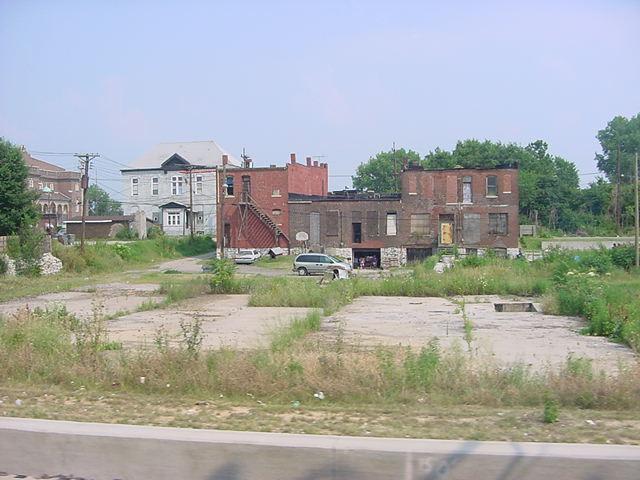Stuff Black People Don’t Like
February 23, 2015
To paraphrase an instrumentally pleasing Pink Floyd song, “Is it only a dream that there’ll be, only turning away?”
Why even bring this song up (On the Turning Away)?
We’ll get to that in a minute.
But to truly understand the melancholy nature of what you are about to read, you must remember there was a time – not too long ago – when those same barren, deserted streets were filled with the laughter of children and the promise of tomorrow.
The laughter of white children and the promise tomorrow would be better than yesterday.
But the tomorrow so many people hoped was coming never came; instead, the hopes and dreams of yesterday went unfulfilled, with the memories those white families made long ago now carted away… [Thieves Cart Off St. Louis Bricks, New York Times, 9-19-2010]
To truly understand the overwhelming despondency of what you are about to read, recall that once America’s white leaders didn’t turn away from the plight of black people and erected the Pruitt-Igoe public housing complex in St. Louis to give them a better life… though the ultimate lesson would be one those same white leaders would quickly turn away from ever acknowledge (that no matter the money spent; no matter the infrastructure built to better the lives of blacks; wherever blacks are found in America, Africa in America will ultimately arise).
Brick thievery in the once-thriving (when it was filled with white people) now blighted – because it is filled with black people – area North St. Louis is perhaps the most fitting legacy of what Africans in American do to European civilization.
They dismantle brick by brick.
And now we come to an article even an individual owning the most bleeding heart would read and quickly find it coagulating. [Proud but downtrodden St. Louis neighborhood struggles with prospect of National Geospatial-Intelligence Agency, St. Louis Post-Dispatch, 2-21-15]:
The houses in the city’s St. Louis Place neighborhood have slowly disappeared, brick by brick — once-handsome homes destroyed by developers and thieves.
Over the years, the western edge of the old neighborhood near downtown, formerly a home to the city’s upper class, has virtually evaporated. And soon, if the city has its way, it will be completely cleared to move the National Geospatial-Intelligence Agency to north St. Louis.
While vast stretches of the area already are vacant, the neighborhood is flecked with sporadic clusters of proud homes and businesses. Some blocks are populated only by stray dogs, while others contain a house or two. Now, the city hopes the federal government chooses the site for its massive high-tech spy facility over three other potential sites in the region, including a spot near Scott Air Force Base.
To that aim, St. Louis aldermen passed a bill authorizing the city to use eminent domain to buy up the remaining homes and buildings as part of an effort to keep the agency’s 3,100 jobs within the city’s borders.
One of those houses belongs to Joyce Cooks, a teacher who has lived there for more than 40 years.
“Across the street there was a man who got sick and died,” Cooks remembered. “The man wasn’t dead two weeks before his house came down. They just pulled the top off of that house. Then they came back to steal the bricks.”
Cooks’ three-story home, built in 1893, is one of the few left on Warren Street. She has seen the houses around her either destroyed by brick thieves or bought by developers and left to rot. Still, it’s her home, and she wants to stay.
The city has promised to pay fair market value for all property in the redevelopment area, bordered on the east and west by North Jefferson Avenue and North 22nd Street, and sell it to the federal government. A city official pledged last week that the city wouldn’t force property owners to sell if the site isn’t selected for the new facility.
Homeowners in the neighborhood argue, however, that such an arrangement would leave an uncertainty over their property until the federal government makes a decision, which isn’t expected until 2016.
The city says it will appraise each property and use that as a starting point in negotiations. Homeowners can also get their own appraisal. The city promises to pay at least market rate or higher, in addition to moving costs.
Cooks says the money won’t be enough for her to find a similar-sized home.
“I have lived in a house all my life,” Cooks said. “I have never lived in an apartment. I have 16-inch-thick brick walls, high ceilings, wooden floors, crown moldings. I’m going to fight to the end to stay. They might have to carry me out of here.”
The city promises that it will try to keep homeowners nearby, if they choose to remain a part of the community.
Just south of Cooks’ home is a large wooded swath that creates a rural feel in an urban area with views of downtown. It formerly housed the failed Pruitt-Igoe housing complex, which was the original proposed site for the Geospatial Agency structure. Officials said they had to expand from there because the agency required more room for its facility, and now none of the development will actually occur on the site.
They hope the neighboring federal facility would spur development on the site.Pruitt-Igoe’s giant towers once loomed over this neighborhood. And, in many ways, they still do.
“I never lived in public housing, but they put [Pruitt-Igoe] here anyway,” Cooks said. “I saw it come down. I ran into the house so the dust wouldn’t get into my lungs.”
Pruitt-Igoe is central to the city’s argument for the Geospatial Agency to stay in St. Louis. Local officials have said the failed federal housing policies of the 1950s that led to the rise and fall of Pruitt-Igoe is one reason to give a boost to the city now.
Earlier this month, 5th Ward Alderman Tammika Hubbard, who represents the area, pleaded with aldermen to support the city’s relocation effort of about 50 homes and businesses.
“I can attest firsthand some of the atrocities that were associated with Pruitt-Igoe,” Hubbard said. “I looked at this as an opportunity for the government to right some of their wrongs … Some members of my family are no longer here because of some of the things that took place in Pruitt-Igoe.”
She added: “Think about the 60 years disinvestment, think about the crime, think about a ward that has the highest rate in just about everything.”
City officials further argue that the location falls within President Barack Obama’s “livable communities” initiative, which aims to foster dense urban areas, reduce sprawl and pollution and keep federal jobs near areas served by mass transit.
Just north of Pruitt-Igoe sits Faultless Healthcare Linen, a business that received real estate and property tax abatement to move to north St. Louis. It will cost $10 million to $15 million to clear it for the Geospatial Agency.
The company employs 146 people at the location.
“We look forward to learning more about the overall plan and understanding how we can support the effort,” said Susan Witcher, chief executive of the Kansas City-based company.
St. Louis Place neighborhood is 91 percent black. Every negative characteristic mentioned in the St. Louis Post-Distpach article that’s associated with the 91 percent black community exists because the neighborhood is inhabited by almost entirely by Africans in America.
They have taken the European civilization (and infrastructure) they inherited from whites – via white flight from black crime and the depreciating home values associated with rising percentages of blacks in the community – and dismantled it… literally brick by brick.
The houses in the city’s St. Louis Place neighborhood have slowly disappeared, brick by brick — because of individual black people collectively imposing their genetic fingerprint on an area where once-handsome homes were built to shelter generations of white people.
Over the years, the western edge of the old neighborhood near downtown, formerly a home to the city’s upper class, has virtually evaporated because white flight drained the vitality and genetic material necessary to maintain this now 91 percent black community (sic) where vast stretches of the area already are vacant and some blocks are populated only by stray dogs, while others contain a house or two.
In a span of roughly 100 years, since The Birth of a Nation debuted, the white past of the St. Louis Place neighborhood has been all but erased by Africans in America, who hilariously were responsible with the razing of the Pruitt-Igoe public housing complex built in the same area.
No, it’s time we turn away for good and realize the lesson to learn from St. Louis is simply this: no matter what Europeans in America build, if Africans in America inherit it, ultimately it will regress to the black mean.
Brick by brick if need be… “Is it only a dream that there’ll be, only turning away?”
 Daily Stormer The Most Censored Publication in History
Daily Stormer The Most Censored Publication in History



